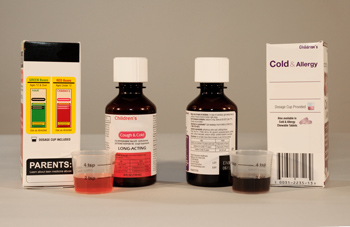For Consumers
Ten Tips to Prevent an Accidental Overdose
Always use the cup, syringe, or other dosage device that comes with a medicine. A different device, or a kitchen spoon, could hold the wrong amount. Download this hi-res photo from Flickr. |
 Get Consumer Updates by E-mail
Get Consumer Updates by E-mail
 Share copies of this article (721 KB)
Share copies of this article (721 KB)
For a medicine to work for you—and not against you—you’ve got to take the right dose.
Many over-the-counter liquid medicines—such as pain relievers, cold medicine, cough syrups, and digestion aids—come with spoons, cups, oral droppers, or syringes designed to help consumers measure the proper dose. These “dosage delivery devices” usually have measurement markings on them—such as teaspoons (tsp), tablespoons (tbsp), or milliliters (mL).
But the markings aren’t always clear or consistent with the directions on the medicine’s package. The Food and Drug Administration (FDA) has received numerous reports of accidental overdoses—especially in young children—that were attributed, in part, to the use of dosage delivery devices that were unclear or incompatible with the medicine’s labeled directions for use.
On May 4, 2011, FDA issued a guidance to firms that manufacture, market, or distribute over-the-counter liquid medicines. The guidance calls for them to provide dosage delivery devices with markings that are easy to use and understand.
Parents and caregivers can do their part, too, to avoid giving too much or too little of an over-the-counter medicine. Here are 10 tips:
- Always follow the directions on the Drug Facts label of your medicine. Read the label every time before you give the medicine.
- Know the "active ingredient" in the medicine. This is what makes the medicine work and it is always listed at the top of the Drug Facts label. Many medicines used to treat different symptoms have the same active ingredient. So if you're treating a cold and a headache with two different medicines but both have the same active ingredient, you could be giving two times the normal dose. If you're confused, check with a doctor, nurse, or pharmacist.
- Give the right medicine, in the right amount. Medicines with the same brand name can be sold in different strengths, such as infant, children, and adult formulas. The dose and directions also vary for children of different ages or weights. Always use the right strength and follow the directions exactly. Never use more medicine than directed unless your doctor tells you to do so.
- Talk to your doctor, pharmacist, or nurse to find out what mixes well and what doesn't. Medicines, vitamins, supplements, foods, and beverages aren’t always compatible.
- Use the dosage delivery device that comes with the medicine, such as a dropper or a dosing cup. A different device, or a kitchen spoon, could hold the wrong amount of medicine. And never drink liquid medicine from the bottle.
- Know the difference between a tablespoon (tbsp) and a teaspoon (tsp). A tablespoon holds three times as much medicine as a teaspoon. On measuring tools, a teaspoon (tsp) is equal to "5 mL."
- Know your child's weight. Dosage amounts for some medicines are based on weight. Never guess how much to give your child or try to figure it out from the adult dose instructions. If a dose is not listed for your child's weight, call your health care professional.
- Prevent a poison emergency by always using a child-resistant cap. Relock the cap after each use. Be especially careful with any medicines that contain iron; they are the leading cause of poisoning deaths in young children.
- Store all medicines in a safe place. Some are tasty, colorful, and many can be chewed. Kids may think they’re candy. Store all medicines and vitamins out of your child's (and your pet's) sight and reach. If your child takes too much, call the Poison Center Hotline at 800-222-1222 (open 24 hours a day, 7 days a week) or call 9-1-1.
- Check the medicine three times before using. For any medicine, it is always good practice to first, check the outside packaging for such things as cuts, slices, or tears. Second, once you’re at home, check the label on the inside package to be sure you have the right medicine and that the lid and seal are not broken. Third, check the color, shape, size, and smell. If you notice anything unusual, talk to a pharmacist or other health care professional before using.
This article appears on FDA's Consumer Updates page, which features the latest on all FDA-regulated products.
Consumer Updates on Safe Use
Safe Use Initiative: Preventing Harm from Medicines FDA: Limit Use of 80 mg Simvastatin FDA Acts to Reduce Harm from Opioid Drugs How to Dispose of Unused Medicines Reducing Fever in Children: Safe Use of Acetaminophen Lock it Up: Medicine Safety in Your Home Improperly Discarded 'Sharps' Can Be Dangerous
For More Information
- Press Release: FDA issues final guidance for liquid OTC drug products with dispensing devices
Over-the-Counter (OTC) Dosage Delivery Devices - Questions and Answers on Dosage Delivery Devices for Over-the-Counter Liquid Medicines
Medication Errors - Guidance for Industry: Dosage Delivery Devices for Orally Ingested OTC Liquid Drug Products (PDF - 595KB)
Drug Interactions: What You Should Know - Safe Use Initiative









